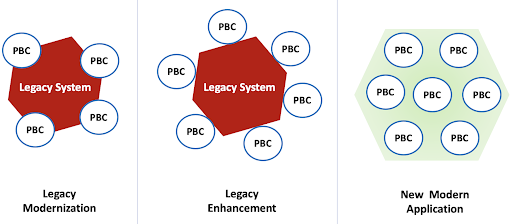Packaged Business Capabilities for M&E Digital Transformation
PBCs play a pivotal role in expediting the digital transformation of M&E organizations by enabling incremental innovations

"PBCs are reusable software components that constitute the fundamental building blocks of a composable enterprise."
Media and Entertainment organizations are grappling with the constraints of legacy technology and the pressing need to accelerate their digital transformation efforts. The imperative to modernize and enhance legacy systems is a central driving force in the M&E market. Business managers often aspire to offer innovative digital services, but they are encumbered by legacy technologies that prove costly to update and disruptive to replace.
A pivotal catalyst for digital transformation within the M&E market is the necessity to replace or upgrade legacy Content Management Systems (CMS), Digital Asset Management (DAM), and Media Asset Management (MAM) systems that were predominantly acquired in the past decade. Presently, these systems pose a substantial hurdle to progress in automating the multifaceted processes essential to the M&E industry. Their inflexibility and sluggishness hinder the creation of new services and the swift integration of an expanding array of cloud applications.
In today's business landscape, M&E enterprises seek to maximize automation wherever feasible. Therefore, when they invest in an asset management solution, they aim for software defined workflows that can seamlessly transition between on-premises, cloud, or hybrid deployments. Equally significant is the desire to expand the range of tools available, enhancing flexibility to design workflows that align seamlessly with current applications and any future tools that their teams may embrace over time.
Composable Technology
Why opt for modular application architecture? In the context of (M&E) enterprises, applications have grown in size and complexity, which can make them challenging to manage, update, and innovate. Modularity is the approach of breaking applications into discrete components that can be managed independently, yet seamlessly integrated into the larger system.
This modular approach is the foundation of composable digital technologies, which simplifies the advancement of digital transformation for companies without adding bureaucracy or exacerbating existing inefficiencies. The benefits of a modular architecture are manifold:
- Enhanced Manageability and Scalability: Modularity reduces complexity, making it easier to cater to the evolving needs and expectations of business users.
- Team and Technology Autonomy: Organizations can allocate projects around specific business functions, fostering efficiency and process optimization.
- Resilience: In a modular architecture, functional isolation allows for fault containment.
Modern applications must be inherently modular, enabling companies to create and evolve experiences and services at a pace that was inconceivable just a decade ago. The flexible coupling of modules minimizes service dependencies, resulting in improved value when purchasing, building, expanding, or configuring services. This shift in the economics associated with digital transformation enhances the new digital experience.
Packaged Business Capabilities
The ability to rapidly create business-ready applications and solutions empowers us to design and adapt new services on demand by harnessing the technological capabilities of a media application integration platform, partner integrations, and key customizations. These are pre-composed solutions.
Packaged Business Capabilities (PBCs) represent applications or services tailored around specific business functions. They are software components embodying a well-defined business capability, readily recognizable by business users, and suitable for reuse in the creation of custom-assembled products, applications, and services.
The intrinsic modularity of PBCs positions them as foundational elements for applications or solutions, akin to aggregations of microservices. Microservices serve as the framework for designing, building, and deploying modular applications, and PBCs encapsulate these application services. This confluence is especially advantageous for companies that demand high levels of flexibility, security, agility, and transparency.
Leveraging PBCs to construct cloud-native applications furnishes Media and Entertainment (M&E) organizations with an expeditious and cost-effective means to modernize services and systems integral to their operations. PBCs offer an array of advantages, including:
- Addressing common business challenges;
- Facilitating cross-functional decision-making;
- Accelerating scalability and time to market;
- Mitigating dependence on single suppliers, and
- Encouraging the adoption of best-in-class solutions available in the market.
Furthermore, the combination of multiple PBCs can give rise to composable applications, often referred to as "smartPacks," enabling companies to offer comprehensive end-to-end services without making substantial investments in new systems.
The current user interface technology, coupled with the composability of PBCs, elevates the application experience through straightforward plug-and-play actions. This approach reflects a no-code paradigm in software development, permitting the creation of applications without prior expertise in traditional programming languages. Citizen developers or those with limited programming experience can assemble applications using PBCs and graphic workflow designers.
PBCs present a solution that enables businesses to incrementally introduce new digital services at a pace that balances customer demands with budget constraints. These building blocks can be targeted at specific business functions and deployed independently. PBCs carry minimal risk and disruption, allowing companies to modernize specific components within larger systems.
PBC-Based Modernization
In typical large on-premise installations, vendors often deliver various point-to-point integrations and custom functionalities for customers, resulting in each installation being unique. Over time, managing multiple versions of such software becomes increasingly challenging.
Investing in expanding the functionality or integrations of legacy systems, which are reliant on the provider, is generally an unsound business practice. A more advantageous approach is to temporarily integrate the legacy system with an application integration platform, specifically an iPaaS designed for media.
This approach opens up opportunities for the customer to evolve their business by temporarily halting the development of the legacy system and incorporating necessary new products and workflows. This strategy ensures business continuity while allowing the gradual phase-out of the legacy system in the future.
To ensure the business continuity of M&E organizations, it is imperative to establish an integration strategy for legacy systems, particularly in the context of many CMS, DAM, and MAM systems. One immediate question arises: Can a monolithic application serve as a (PBC? The answer is affirmative, provided that the application offers an API organized into functional blocks. Each of these functional blocks corresponds to a distinct PBC, readily identifiable by a business user. It's essential to understand that this is a temporary solution to facilitate the organization's digital transition towards a composable architecture.
M&E organizations face major challenges around modernizing legacy applications, replacing manual processes, and implementing new digital services. But complete system replacement is expensive and time-consuming. And pre-built applications are rarely tailored to the specific needs of organizations, leading to costly modernization. It's time to consider a new approach based on PBCs that allows M&E organizations to use lightweight application building blocks to deploy new services or incrementally replace entire applications.
PBCs play a pivotal role in expediting the digital transformation of M&E organizations by enabling incremental innovations. There are three primary modernization approaches that companies can consider:
- Legacy Modernization: Many companies operate with legacy systems that would be too time-consuming and costly to entirely replace. In such cases, PBCs can be employed to substitute and upgrade functionalities within a larger legacy system.
- Legacy Enhancement: When companies are content with their current systems, they can introduce PBCs to expand existing functionalities. This enables companies to offer new end-to-end services without significant investments.
- New Modern Applications: In situations where companies have manual processes that need automation and have resources available for new developments based on microservices, PBCs can replace traditional workflows with modern applications. Additionally, this approach accelerates the transition to the cloud, either partially or comprehensively, based on the company's preferences.
The imperative to modernize and enhance legacy systems serves as a prominent driving force in the M&E market. Fortunately, PBCs offer a practical alternative, enabling companies to modernize quickly and incrementally. The specific functionalities of PBCs and their mix-and-match reusability to create composable applications can significantly assist companies in their digital transformation, reducing development time and modernization project costs.
We have discussed the challenges faced by M&E organizations in terms of legacy technology and the need for digital transformation. We have also emphasized the importance of modernization, flexibility, and the integration of new technologies. To accelerate digital transformation, we propose an agile and composable integration platform, based on PBC (no-code iPaaS for media), for the creation of media services that will pave the way for continuous and future-proof innovation.

Get the TV Tech Newsletter
The professional video industry's #1 source for news, trends and product and tech information. Sign up below.

Emilio L. Zapata is the founder of Tedial.
